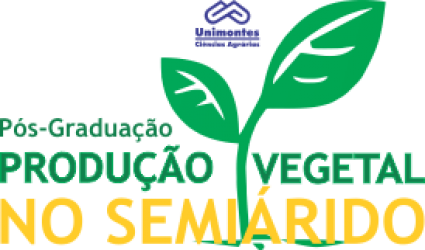- Version
- Download 23
- Tamanho do Arquivo 750.92 KB
- Data de Criação 11/06/2021
- Download
FERNANDES, Martielle Batista. Termoterapia no manejo da antracnose e conservação pós-colheita da banana ‘Prata-Anã’. 2014. 56 p. Dissertação (Mestrado em Produção Vegetal no Semiárido) – Universidade Estadual de Montes Claros, Janaúba, 2014.
A termoterapia pode controlar diretamente os fitopatógenos ou ativar mecanismos de defesa dos frutos. Dessa forma, o trabalho teve como objetivo avaliar o uso da termoterapia no manejo da antracnose e conservação pós-colheita da banana ‘Prata-Anã’ produzida no Norte de Minas Gerais. Buquês de bananas foram atomizados com suspensão de esporos de Colletotrichum musae e imersos em água a 40, 44, 48, 52 e 56 °C durante 4, 8, 12 e 16 minutos. As testemunhas constituíram de frutos imersos em água a 20 °C com e sem inoculação do fungo. Os buquês foram armazenados a 25±1 °C e 80±5 % UR, analisados quanto à incidência e severidade de antracnose durante 15 dias, em intervalos de três dias, totalizando cinco avaliações. O delineamento utilizado foi DIC com fatorial 5 x 4 x 5 + 2. Os dados foram submetidos à análise de variância e ao teste de Scott-Knott (P < 0,05). As testemunhas foram submetidas ao teste de Dunnett (P < 0,05). A avaliação da termoterapia associada ao controle químico foi realizada por meio da imersão dos frutos a 52 °C por 8 minutos. Parte dos frutos tratados foi pulverizada com fungicida Imazalil. Os tratamentos consistiram em frutos submetidos à termoterapia com e sem aplicação de fungicida, sendo as testemunhas os frutos sem a termoterapia com e sem aplicação do fungicida. Os frutos foram armazenados a 25±1 °C e 80±5 % UR em delineamento inteiramente casualizado. Os dados foram submetidos à análise de variância e comparados pelo teste F, sendo as testemunhas comparadas aos tratamentos pelo teste de Dunnett (P<0,05). A avaliação das características físicas e químicas dos frutos foi utilizando frutos tratados a 52 °C por 8 minutos e armazenados a 9, 11, 13 e 15 °C. As avaliações foram realizadas a cada cinco dias por 30 dias. O delineamento utilizado foi DIC com fatorial 4 x 6, sendo os dados submetidos à análise de variância e regressão. A termoterapia à temperatura de 52 °C por 8 minutos de imersão reduziu a severidade da antracnose nos frutos de 29,66 % para 3,58 %. A temperatura de 56 °C foi prejudicial aos frutos levando a maior severidade da doença. A associação termoterapia/tratamento químico foi eficiente no manejo da antracnose com redução da doença em 20,99 %. A utilização da termoterapia em banana ‘Prata-Anã’ com uso de embalagem de polietileno de baixa densidade permitiu um período de 30 dias de armazenamento a 13 ºC com adequada manutenção da firmeza, coloração, teores de sólidos solúveis, acidez e pH. A termoterapia aplicada na banana ‘Prata-Anã’ em pós-colheita mostrou-se eficiente no manejo da antracnose e conservou as características físicas e químicas dos frutos.
Palavras-chave: Musa sp.; tratamento hidrotérmico, Colletotrichum musae, prolongamento da vida útil.
Thermotherapy in the management of anthracnose and postharvest conservation of “Prata-Anã” banana
Thermotherapy can directly control plant pathogens and activate defense mechanisms of the fruit. Thus, the study aimed to evaluate the use of thermotherapy in the management of anthracnose and postharvest conservation of ‘Prata-Anã’ banana produced in the North of Minas Gerais. Bunches of bananas were sprayed with the suspension of Colletotrichum musae spore and immersed in water at 40, 44, 48, 52 and 56 °C for 4, 8, 12 and 16 minutes. The controls constituted of fruit immersed in water at 20 °C with and without inoculation of the fungus. The bunches were stored at 25 ± 1 °C and 80 ± 5 % RH, analyzed as for the incidence and severity of injury for 15 days every three days, in a total of five evaluations. The design entirely at random in a 5 x 4 x 5 + 2 factorial. Data were subjected to analysis of variance and Scott-Knott test (P<0.05). Controls were subjected to Dunnett test (P<0.05). The thermotherapy evaluation associated with chemical control was performed by immersion of the fruits at 52 °C for 8 minutes. Part of the treated fruits was sprayed with fungicide Imazalil. The treatments consisted of fruits submitted to thermotherapy with or without fungicide application, being the controls the fruits without thermotherapy with and without fungicide application. The fruits were stored at 25 ± 1 °C and 80 ± 5 % RH in a randomized design. Data were subjected to analysis of variance and compared by F test, and the controls compared to treatments by Dunnett’s test (P<0.05). The evaluation of the physical and chemical characteristics of the fruits was by means of treated fruits at 52 °C for 8 minutes and stored at 9, 11, 13 and 15 °C. The evaluations were performed every five days for 30 days. The design was at random with a 4 x 6 factorial, and the data subjected to analysis of variance and regression. The thermotherapy at 52 °C for 8 minutes immersion reduced the severity of anthracnose on fruits from 29.66 % to 3.58 %. The temperature of 56 °C damaged the fruits causing greater disease severity. Combination of thermotherapy/chemical treatment was effective for managing anthracnose disease with decrease of 20,99 %. The use of thermotherapy in ‘Prata-Anã’ banana with low density polyethylene package allowed a period of 30 days of storage at 13 °C with adequate maintenance of firmness, color, content of soluble solids, acidity and pH. Thermotherapy applied in ‘Prata-Anã’ banana in post-harvest proved to be efficient in the management of anthracnose and preserved the physical and chemical characteristics of the fruits.
Keywords: Musa sp.; hydrothermal treatment, Colletotrichum musae, shelf life lengthening

